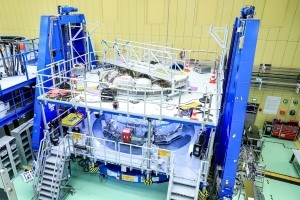Airbus delivers second composites-intensive European Service Module for NASA’s Orion spacecraft
The ESM-2 module, comprising carbon fiber sheets and 19-meter CFRP solar array wings, will provide propulsion, power and thermal control, as well as oxygen and water for astronauts on the Artemis II mission.

Integration of the ESM-2 for Orion. Photo Credit: Airbus
It was announced on Oct. 6 that the second composites-intensive European Service Module (ESM-2), built by Airbus (Toulouse, France) for NASA’s Orion spacecraft for the Artemis I and II moon missions, is ready for delivery from the Airbus site in Bremen, Germany. An Antonov cargo aircraft will fly the ESM-2 to NASA’s Kennedy Space Center in Fla., U.S. The European Space Agency (ESA) has selected Airbus as the prime contractor for the development and manufacture of six ESMs with the first ESM to fly soon on NASA’s Artemis I mission.
Airbus says the ESM is a key element of Orion, the next-generation spacecraft that will transport astronauts beyond low Earth orbit (LEO) for the first time since the end of the Apollo program in the 1970s. Comprised of more than 20,000 parts and components, ESM-2 is a cylinder around four meters high and wide. It has a distinctive four solar array wings (SAW, 19 meters across when unfurled) that generates enough energy to power two households. The service module’s 8.6 tons of fuel can power the main engine, eight auxiliary thrusters and 24 smaller thrusters used for attitude control.
While its primary structure is made from machined aluminum, the web assembly is composed of carbon fiber sheets and aluminum sandwich, to stiffen the central core and accommodate most of the ESM equipment (i.e., pressurant tanks, water tanks, etc.). The craft’s four SAW are each composed of three deployable carbon fiber-reinforced polymer (CFRP) rigid panels; at launch, the ESM weighs a total of just over 13 tons.
Overall, the module provides propulsion, power and thermal control and will supply astronauts with water and oxygen on future missions. Furthermore, the unpressurized service module can be used to carry additional payload. The ESM is installed underneath the crew module and together they form the Orion spacecraft, which will reportedly enables astronauts to be transported further into space than ever before.
“Delivery of the second European Service Module for NASA’s Orion spacecraft marks another huge step forward on the journey to return astronauts to the moon,” says Andreas Hammer, head of space exploration at Airbus. “Working hand in hand with our customers ESA and NASA, and our industrial partner, Lockheed Martin Space [see “Lockheed Martin opens new facility, expands Orion spacecraft production”], the program is moving apace and we are ready to meet the challenges of returning to the lunar surface in 2024.”

Photo Credit: Airbus
ESM-2 underwent a comprehensive validation process prior to being readied for shipment including gimbal testing of the module’s main engine (which swivels from side to side for maneuvering and directional control during spaceflight). This main engine is a refurbished engine from Space Shuttle Atlantis orbiter spacecraft.
After completing its trans-Atlantic voyage, Airbus says the ESM-2 will be mated with the Orion Crew Module and undergo further extensive testing before integration with the launcher, a process that will take around two years.
The launch of the first Orion spacecraft on NASA’s new Space Launch System rocket will be uncrewed and take the spacecraft more than 64,000 kilometers beyond the moon in order to demonstrate its capabilities. The first human spaceflight mission, Artemis II, will be powered by ESM-2. Eventually, the Orion spacecraft will transport four astronauts, providing life support for the crew during the flight and enabling a safe return to Earth’s atmosphere, at extremely high re-entry speeds.
In the longer term, ESM is planned to dock Orion spacecraft with the International Lunar Gateway, a moon orbiting platform that will enable a sustainable space exploration architecture extending humanity’s presence in space.
Related Content
PEEK vs. PEKK vs. PAEK and continuous compression molding
Suppliers of thermoplastics and carbon fiber chime in regarding PEEK vs. PEKK, and now PAEK, as well as in-situ consolidation — the supply chain for thermoplastic tape composites continues to evolve.
Read MoreMaterials & Processes: Fibers for composites
The structural properties of composite materials are derived primarily from the fiber reinforcement. Fiber types, their manufacture, their uses and the end-market applications in which they find most use are described.
Read MoreMaterials & Processes: Resin matrices for composites
The matrix binds the fiber reinforcement, gives the composite component its shape and determines its surface quality. A composite matrix may be a polymer, ceramic, metal or carbon. Here’s a guide to selection.
Read MoreThermoplastic composites welding advances for more sustainable airframes
Multiple demonstrators help various welding technologies approach TRL 6 in the quest for lighter weight, lower cost.
Read MoreRead Next
From the CW Archives: The tale of the thermoplastic cryotank
In 2006, guest columnist Bob Hartunian related the story of his efforts two decades prior, while at McDonnell Douglas, to develop a thermoplastic composite crytank for hydrogen storage. He learned a lot of lessons.
Read MoreComposites end markets: Energy (2024)
Composites are used widely in oil/gas, wind and other renewable energy applications. Despite market challenges, growth potential and innovation for composites continue.
Read MoreCW’s 2024 Top Shops survey offers new approach to benchmarking
Respondents that complete the survey by April 30, 2024, have the chance to be recognized as an honoree.
Read More
























